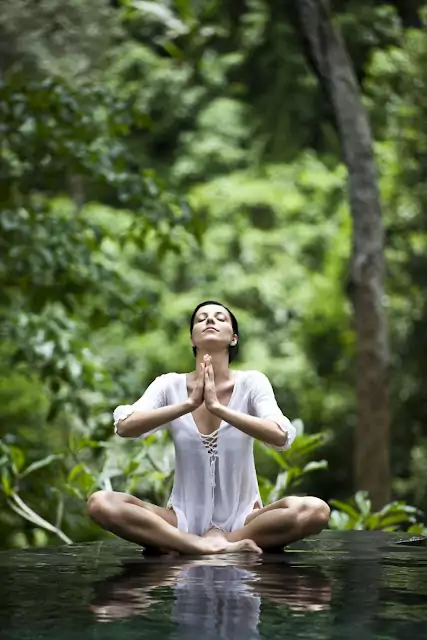With an ever growing number of different yoga styles, it can be hard to know what they stand for, even for long time yogis. Most intermediate and advanced yogis may have an idea about traditional yoga styles such as Iyengar, Asthanga and Shivananda Yoga – but what about Viniyoga or Tri-Yoga? And of all the many yoga styles, which are the ones focusing more on fitness and which ones are more spiritually oriented? Beginners might be especially interested to know if a specific yoga style is more challenging or gentle.
Hatha Yoga
Hatha Yoga is the Indian prototype of yoga, out of which all our present day styles have been developed. Hatha Yoga is also an umbrella term that refers to the practice of yoga postures (asanas) combined with breathing and purification techniques (pranayama and shat kriyas) as well as deep relaxation and meditation. In traditional Hatha Yoga, the postures are typically held for long periods of time and in a meditative atmosphere.
Anusara Yoga
Anusara Yoga was founded by American yoga teacher John Friend and emphasizes a life-affirming and heart-oriented attitude. Anusara teachers believe that proper alignment and the positive effects of yoga postures are enhanced by a practice that is both joyful and intuitive.
Ashtanga-Vinyasa Yoga
This is a dynamic, powerful yoga style developed by the legendary Indian yoga teacher Pattabhi Jois (1915 -2009). It works with six specific series of asanas and certain elements of movement used to connecting the poses, creating a flow between the static traditional postures. There is a strong focus on the breathing.
Bikram Yoga
Bikram Yoga was developed by another Indian yoga teacher called Bikram Choudhury. It consists of a series of 24 postures and two breathing exercises (pranayama) and is meant to develop strength, flexibility and balance. A special feature is that the practice takes place in a heated room (up to 105 degrees Fahrenheit or 40 degrees Celsius) as the additional sweating is meant to detoxify the body. Quite understandably, Bikram Yoga is therefore also called Hot Yoga.
Integral Yoga
This discipline integrates asanas, deep relaxation, breathing techniques and meditation into a holistic, integral practice with a strong spiritual orientation. It was developed by Swami Satchidananda (1914 – 2002), a disciple of Swami Sivananda Saraswati. Its spiritual center is the Satchidananda Ashram-Yogaville, situated in Buckinham, Virginia (USA).
Iyengar-Yoga
Being one of the most popular and widespread yoga styles, Iyengar Yoga is well known for its extensive use of props (such as belts, blocks, chairs and benches) as well as its great attention to detail and focus on correct alignment. Students generally appreciate the detailed instructions, including information on health benefits. Iyengar Yoga was developed by the Indian yoga teacher B.K.S. Iyengar.
Jivamukti Yoga
Jivamukti is a Sanskrit term meaning “liberation of the soul.” This spiritually oriented and more traditional form of yoga was developed by American yoga teachers Sharon Gannon and David Life. It works with specific series of relatively long held asanas which are connected in a dynamic and flowing manner. Ethical behavior such as vegetarianism and environmental awareness are being encouraged.
Kripalu Yoga (Amrit Yoga)
This yoga style was founded by Amrit Desai. It is a both therapeutic and spiritual approach to yoga. This gentle practice aims at calming the mind and developing a non-judgemental attitude towards one’s practice and oneself. The Kripalu Center for Yoga and Health is based in Stockbridge, Massachusetts (USA).
Kundalini Yoga
Kundalini Yoga was introduced to the USA by the Indian yoga teacher Yogi Bhajan in the 1960s. This is a very rigorous, intense practice which aims at awakening the serpent power (Kundalini) resting at the base of the spine. The postures are held for long periods of time with emphasis on (often forceful) breathing.
Power Yoga
Power Yoga is a simplified, dynamic and rigorous form of Ashtanaga Yoga developed by American yoga teacher Bryan Kest. It aims at developing fitness, endurance and vitality. According to founder Bryan Kest, Power Yoga is „about feeling good, not just looking good“.
Sivananda Yoga
Sivananda Yoga was founded by another disciple of Swami Sivananda Saraswati called Swami Vishnu-devananda. It integrates the five principles of exercise (asanas), breathing (pranayama), relaxation (savasana), vegetarian diet and meditation. This yoga style is taught worldwide in various Sivananda Yoga teacher training courses. The German Yoga-Vidya Centers teach an almost identical form of yoga as developed by Sukadev Bretz, a disciple of Swami Vishnu-devananda.
TriYoga®
TriYoga® was founded by American yoga teacher Kali Ray. It combines asanas, pranayama and mudras (sacred hand gestures) to flowing series of asanas called ‘flows.’
Viniyoga
Viniyoga was developed by Indian yoga teacher T.K.V. Desikachar. In this therapeutic style, the main focus is on the coordination of breathing and movement. The asanas are usually held for long periods of time and may be modified to suit one’s age, fitness and state of health.
Vinyasa Flow
In Vinyasa Flow, asanas are held only shortly and connected in a specific manner, creating a flowing movement which is to be closely connected with breathing. These flows are meant to improve flexibility and vitality as well as calm the mind and inspire spiritual awareness and healing. Vinyasa Flow is derived from the traditional Ashtanga-Vinyasa Yoga (see above).
